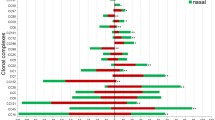Abstract
Principal component analysis was used to demonstrate the main associations between patterns of resistance to antibiotic drugs in 670 gram-negative bacteria consecutively isolated from blood cultures over a period of two years. Six factors were derived, which accounted for 84 % of the total variance of the original matrix. Each factor represented an association between resistance to certain antibiotics as follows: factor 1: aztreonam, third generation cephalosporins and aminoglycosides; factor 2: first and second generation cephalosporins; factor 3: tetracycline and chloramphenicol; factor 4: ampicillin and ureidopenicillins; factor 5: trimethoprim/sulfamethoxazole; factor 6: fluoroquinolones. On two-way analysis of variance the difference in the factor scores was significant between bacteria for all factors except factor 5. The difference in factor scores between community and hospital acquired strains was significant only for factors 1, 2 and 6. Only the score of factor 6 showed a clear trend to increase with time during the two-year study period. Patients who were treated with antibiotics prior to bacteremia had higher scores for all factors, the difference being most marked in patients treated with fluoroquinolones. Factor analysis can be used to describe phenotypic associations between resistance to antibiotics, and the factor score used to compare groups of isolates and to demonstrate temporal and other trends.
Similar content being viewed by others
References
Neu CH The emergence of bacterial resistance and its influence on empiric therapy. Reviews of Infectious Diseases 1983, 5, Supplement: 9–20.
Lupski JR Molecular mechanisms for transposition of drug-resistance genes and other movable genetic elements. Reviews of Infectious Diseases 1987, 9: 357–368.
Mayer KH The epidemiology of antibiotic resistance in hospitals. Journal of Antimicrobial Chemotherapy 1986, 18, Supplement C: 223–233.
Moller JK Monitoring antimicrobial drug-resistance in hospital microorganisms. Danish medical Bulletin 1990, 37: 263–274.
Moller JK A microcomputer assisted analysis of drug resistance in bacteria. Computerized Methods and Programming in Biomedicine 1986, 23: 217–223.
Richardson JF, Marples RR Changing resistance to antimicrobial drugs, and resistance typing in clinically significant strains ofStaphylococcus epidermidis. Journal of Medical Microbiology 1982, 15: 475–484.
Gorsuch RL Factor analysis. W.B. Saunders, Philadelphia, 1974.
Bauer RW, Kirby WMM, Shernis JC, Turck M Antibiotic susceptibility testing by standardized single disk method. American Journal of Clinical Pathology 1966, 45: 493–496.
Leibovici L, Konisberger H, Pitlik SD, Samra Z, Drucker M Predictive index for optimizing empiric treatment of gram-negative bacteremia. Journal of Infectious Diseases 1991, 163: 193–196.
Leibovici L, Samra Z, Konisberger H, Kalter-Leibovici O, Pitlik SD, Drucker M Bacteremia in adult diabetic patients. Diabetes Care 1991, 14: 89–94.
Leibovici L, Konisberger H, Pitlik SD, Samra Z, Drucker M Bacteremia and fungemia of unknown origin in adults. Clinical Infectious Diseases 1992, 14: 436–443.
Cerny BA, Kaiser HF A study of a measure of sampling adequacy for factor-analytic correlation matrices. Multivariate Behavioral Research 1977, 12: 43–47.
Martinez JL, Baquero F Epidemiology of antibiotic-inactivating enzymes and DNA probes: the problem of quantities. Journal of Antimicrobial Chemotherapy 1990, 26: 301–303.
Piddock LJV, Traynor EA, Wise R A comparison of the mechanisms of decreased susceptibility of aztreonam-resistant and ceftazidime-resistantEnterobacteriaceae. Journal of Antimicrobial Chemotherapy 1990, 26: 749–762.
Chang ACY, Cohen SN Construction and characterization of amplifiable DNA cloning vehicles derived from the P15A cryptic miniplasmid. Journal of Bacteriology 1978, 134: 1141–1156.
Muder RR, Brennen C, Goetz AM, Wagener MM, Rihs JD Association with prior fluoroquinolone therapy of widespread ciprofloxacin resistance among gram-negative isolates in a Veteran Administration Medical Center. Antimicrobial Agents and Chemotherapy 1991, 35: 256–258.
Darland G Discriminant analysis of antibiotic susceptibilities as a means of bacterial identification. Journal of Clinical Microbiology 1975, 2: 391–396.
Gyllenberg HG A model for computer identification of microorganisms. Journal of General Microbiology 1965, 39: 401–405.
Author information
Authors and Affiliations
Rights and permissions
About this article
Cite this article
Leibovici, L., Wysenbeek, A.J., Konisberger, H. et al. Patterns of multiple resistance to antibiotics in gram-negative bacteria demonstrated by factor analysis. Eur. J. Clin. Microbiol. Infect. Dis. 11, 782–788 (1992). https://doi.org/10.1007/BF01960876
Issue Date:
DOI: https://doi.org/10.1007/BF01960876




